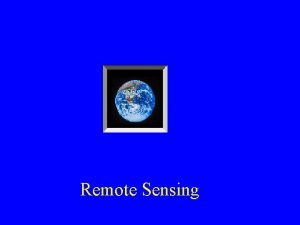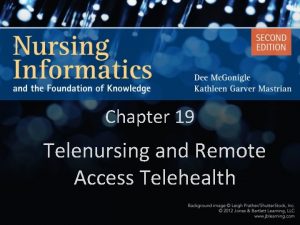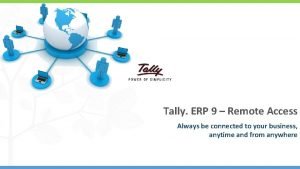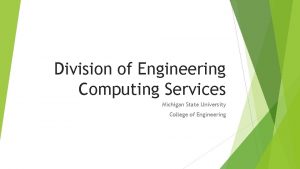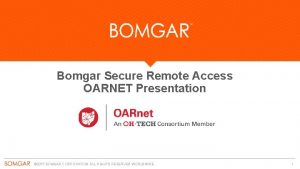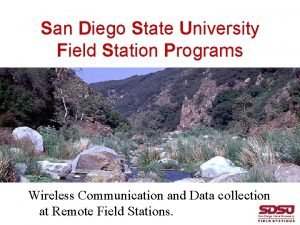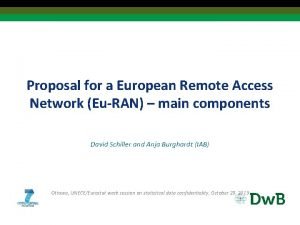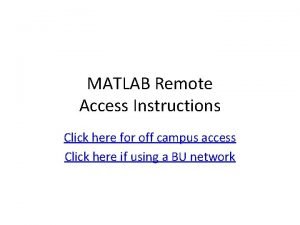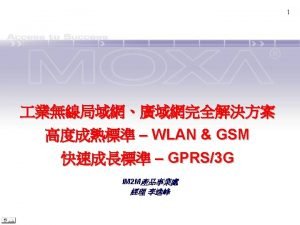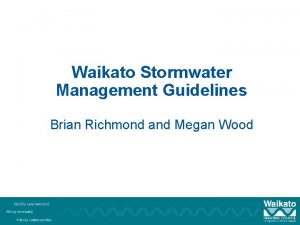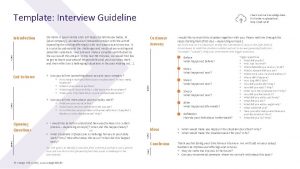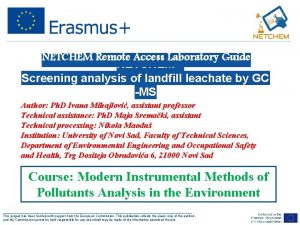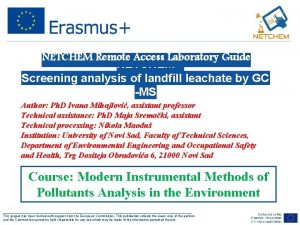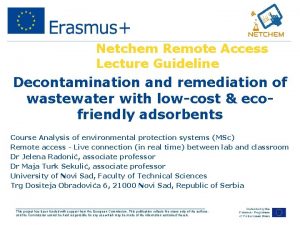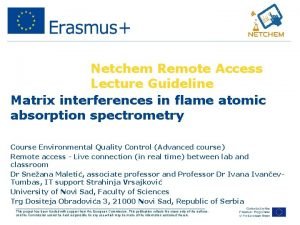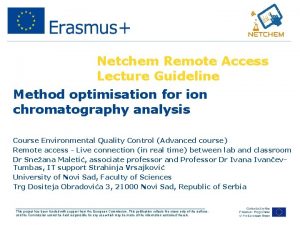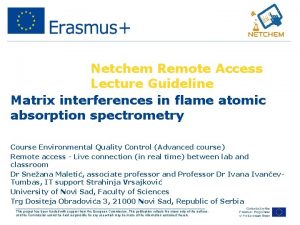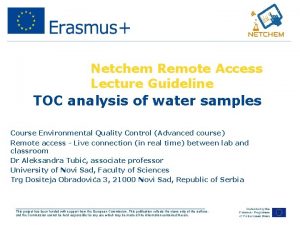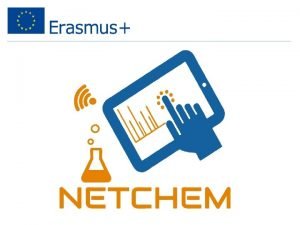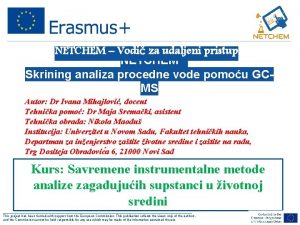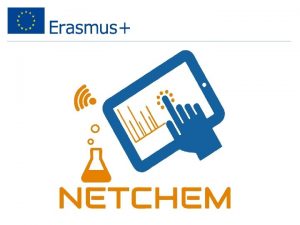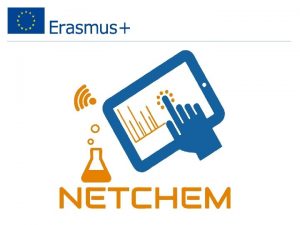Netchem Remote Access Lecture and Theoretical Exercise Guideline












- Slides: 12

Netchem Remote Access Lecture and Theoretical Exercise Guideline Introduction to an example of GC method validation Course Environmental Quality Control (Advanced course) Remote access - Live connection (in real time) between lab and classroom Professor Dr Ivana Ivančev-Tumbas IT support Strahinja Vrsajković University of Novi Sad, Faculty of Sciences Trg Dositeja Obradovića 3, 21000 Novi Sad, Republic of Serbia ___________________________________________________ This project has been funded with support from the European Commission. This publication reflects the views only of the authors, and the Commission cannot be held responsible for any use which may be made of the information contained therein.

Educational objective • To equip the students with the knowledge of GC/MS method validation plan development including all preparatory stepschoice of method for analysis, sample preparation and determination of precision, calibration, extraction efficiencyrecovery, MDL and PQL • Analyte of interest is chosen by the student, professor in charge and mentor of thesis work ___________________________________________________ This project has been funded with support from the European Commission. This publication reflects the views only of the authors, and the Commission cannot be held responsible for any use which may be made of the information contained therein.

Prerequisite and background • Students have to be already familiar with the basics of GC/MS and have to pass the Entrance test before lab work. The test is uploaded on the Moodle platform. • Lab overview, rules, introduction to work with an instrument and explanation of experimental lab capacities are explained by GC/MS laborotory staff (remote access from classroom to laboratory, live connection). • After that students should develop their own method validation plan using general guidelines provided in the Cmap (http: //mdl. netchem. ac. rs/course/view. php? id=25#section-2) and have consultations with their professor (discussions can be scheduled on remote in the termin of consultation since lectures for Ph. D students are mainly consultative). ___________________________________________________ This project has been funded with support from the European Commission. This publication reflects the views only of the authors, and the Commission cannot be held responsible for any use which may be made of the information contained therein.

After introductory lecture student has to: 1. Succesfully pass the Entrance test after Introduction into laborotory remote session 2. Independently develop a theoretical plan for the Method validation with help of literature and Cmap attached (http: //mdl. netchem. ac. rs/course/view. php? id=25#section-2) including sample preparation, data acquisition and data analysis 3. Discuss the plan with their professor (can be done on remote classrom-professor) and if necessary, adjust it 4. In the case when experimental work is chosen to be at the GC/MS instrument, student has to perform experimental method validation according to the developed plan in the laborotory. 4. Upon data collection by GC/MS analysis student has to do the method validation with the help of xls file attached in the Cmap (http: //mdl. netchem. ac. rs/course/view. php? id=25#section-2) and to report and to discuss the results to professor. This also can be performed on remote. ___________________________________________________ This project has been funded with support from the European Commission. This publication reflects the views only of the authors, and the Commission cannot be held responsible for any use which may be made of the information contained therein.

Remote access classroom-laboratory DESCRIPTION OF REMOTE ACCESS 1. NETCHEM COMMUNICATION SIDES (NOTE: NETCHEM Communication is defined as an event that involves all kinds of internet interactions (in real time and not in real time) between participants via devices (PCs, laptops, tablets andmobilephones)) host side (NOTE: Host side of NETCHEM Communication is defined as PC who invites other users to join the session) guest side (NOTE: Guest side of NETCHEM Communication is defined as PC who joins the invitation to session) 1. COMMUNICATION SOFWARE Team Viewer Skype 1. COMUNICATION HARDWARE on host side on guest side 1. Participant’s PC in the laboratory (leturer/professor from lab, for sample prep and GC) Participant’s PC or laptop in the classroom where students watch and listen to the lecture with or without professor and communicate Q/A sessions Meeting: Yes Remote control: No Meeting and Remote control simultaneously: No Call 1: 1: No Conference Call: No 1 PC for each participant, micorphone+, conference camera with speakers 1 PC or laptop, headset with microphone and web camera INFORMATION EXCHANGE TYPE Educational (one side is dominantly receptive) Consultative (two sides are equal in giving-receiving information) Place of Educator participant: lab, optional + classroom Number of educator(s): 1+ optional 1 Place of student participant: classroom Number of student participant(s): up to 10 Number of host side participant(s): Number of guest side participant(s): ___________________________________________________ This project has been funded with support from the European Commission. This publication reflects the views only of the authors, and the Commission cannot be held responsible for any use which may be made of the information contained therein.

Remote access classroom-professor DESCRIPTION OF REMOTE ACCESS 1. NETCHEM COMMUNICATION SIDES (NOTE: NETCHEM Communication is defined as an event that involves all kinds of internet interactions (in real time and not in real time) between participants via devices (PCs, laptops, tablets andmobilephones)) host side (NOTE: Host side of NETCHEM Communication is defined as PC who invites other users Participant’s PC in the office (professor) to join the session) guest side Participant’s PC or laptop for student (NOTE: Guest side of NETCHEM Communication is defined as PC who joins the invitation during consultation to session) 1. COMMUNICATION SOFWARE Meeting: Yes Remote control: No Team Viewer Meeting and Remote control simultaneously: No Call 1: 1: No Skype Conference Call: No 1. COMUNICATION HARDWARE on host side 1 PC or laptop for each participant, micorphone+ camera and speakers on guest side 1 PC or laptop, microphone and camera and speakers 1. INFORMATION EXCHANGE TYPE Educational (one side is dominantly receptive) Consultative (two sides are equal in giving-receiving information) Place of Educator participant: office Number of educator(s): 1 Place of student participant: classroom, home Number of student participant(s): up to 10 Number of host side participant(s): 1 Number of guest side participant(s): up to 10 ___________________________________________________ This project has been funded with support from the European Commission. This publication reflects the views only of the authors, and the Commission cannot be held responsible for any use which may be made of the information contained therein.

Remote Access Connection Instructions What makes these lectures different and unique from other classroom lectures is that we have incorporated a section in each activity to remotely acess laborotories, lecturers from your classroom. Request a remote lecture/ lab session specifying information such as: the day, the time, and the instrument you are interested in using by visiting our web site: http: //netchem. ac. rs/remote-access You will see the list of partners with the instruments provided to chose from. You will be contacted by a Remote Access staff member to set up a test run to ensure you are set up properly and have the required infrastructure. In some cases it will be possible to send samples or verify the in-house sample you would like us to prepare and load for characterization. There are two communications software packages, that will allow us to communicate instructions and answer questions during the session. - Team. Viewer: You can obtain a free download at: https: //www. teamviewer. com/en/index. aspx - Skype ___________________________________________________ This project has been funded with support from the European Commission. This publication reflects the views only of the authors, and the Commission cannot be held responsible for any use which may be made of the information contained therein.

Remote Access Connection Instructions V. You will need: a) Computer with administrator access to install plug-ins and software b) An internet connection c) Speakers d) Microphone e) Projector connected to the same computer f) Web browser (Firefox preferred) g) Camera VI. During the test run you can refer to this guide to perform the following steps, but it’s very important that you only proceed with these steps during your scheduled times. You may interfere with other remote sessions and potentially damage equipment if you log in at other times. a) Open and logon to your Team-viewer account. You will be given the access code to enter at the time of your test and then again during the remote session. § If you are using the Team-viewer software, Remote Access staff will give you the Meeting ID. b) You should soon see the Remote Desktop Share or Video Conference and at this point you can see what is on the screen as if it were your desktop or live video connection (in real time) from laboratory. c) Switch to full screen mode by selecting the maximize screen option in the top right corner of the screen. d) Upon completion of the session, move your mouse to the top right corner of the screen, and click on the X to disconnect the remote session. ___________________________________________________ This project has been funded with support from the European Commission. This publication reflects the views only of the authors, and the Commission cannot be held responsible for any use which may be made of the information contained therein.

Remote Access Connection Instructions • Instructions for using team viewer are in detail explained in Deliverable 2. 2 named Guidelines for courses publishing by WARIAL networking (http: //www. netchem. ac. rs/documents/category/52 -deliverables) • In brief, • The meeting function allows a host to present video call (Video Conference) from a laboratory or the content of his screen (Remote Desktop Share) to other participants (guest). Up to 25 users can join a meeting. • For both cases Educational (one side is dominantly receptive) and Consultative (two sides are equal in giving-receiving information) types of information exchange Video Conference and Remote Desktop Share can be arranged. ___________________________________________________ This project has been funded with support from the European Commission. This publication reflects the views only of the authors, and the Commission cannot be held responsible for any use which may be made of the information contained therein.

• SETTING UP A MEETING (for host) • To host a meeting, switch to Meeting tab in Team. Viewer main window. In the Start meeting area, click on Presentation or Video Call. Session will start with certain Meeting ID (a 9 -digit code, randomly generated for each session). If the invited participant is in the contacts list (My Computers list), just click on their name. If not, they will need to receive a Meeting ID via phone/e-mail. • A list of all the participants will appear in Participants widget. Through this list, the presenter can manage privileges of each attendee. • When all participants join a meeting, video call or presentation can star t. • SETTING UP A MEETING (for guest) • To attend a meeting, if you are invited via presenter's contact list, an invitation message will appear. Simply click on Join button to join the meeting or if you are invited via phone/e-mail, enter the provided Meeting ID, and some informative alias (e. g. your name and/or institution) into Your name field, and click Join meeting. • Regardless of joining method, two windows will appear: the window with presenter's desktop content or window with all video links of all participants, that is the center of all activities, and Team. Viewer Panel (that can be hidden or displayed anytime by clicking the icon on its left side). • When all participants join a meeting, video call or presentation can sta rt. • WHATEVER YOUR ROLE IS YOU CAN SHARE FILES AND CHAT (see instructions at http: //www. netchem. ac. rs/documents/category/52 -deliverables) ___________________________________________________ This project has been funded with support from the European Commission. This publication reflects the views only of the authors, and the Commission cannot be held responsible for any use which may be made of the information contained therein.

Author, Editor and Referee References This remote access laboratory was created thanks to work done primarily at University of Niš. Contributors to this material were: Professor dr Ivana Ivančev-Tumbas Refereeing of this material was done by: ___________ Editing into NETCHEM Format and onto NETCHEM platform was completed by: __________________________________________________________ This project has been funded with support from the European Commission. This publication reflects the views only of the authors, and the Commission cannot be held responsible for any use which may be made of the information contained therein.

References and Supplemental Material The NETCHEM platform was established at the University of Nis in 2016 -2019 through the Erasmus Programme. Please contact a NETCHEM representatives at your institution or visit our website for an expanded contact list. The work included had been led by the NETCHEM staff at your institution. ___________________________________________________ This project has been funded with support from the European Commission. This publication reflects the views only of the authors, and the Commission cannot be held responsible for any use which may be made of the information contained therein.
 Microwave remote sensing lecture notes
Microwave remote sensing lecture notes Telenursing and remote access telehealth
Telenursing and remote access telehealth 01:640:244 lecture notes - lecture 15: plat, idah, farad
01:640:244 lecture notes - lecture 15: plat, idah, farad How to access tally from remote
How to access tally from remote Decs remote access
Decs remote access Bomgar features
Bomgar features Remote file access in distributed file system
Remote file access in distributed file system Sdsu remote access
Sdsu remote access Remote access european commission
Remote access european commission Matlab remote access
Matlab remote access Csd remote access
Csd remote access Waikato stormwater management guideline
Waikato stormwater management guideline Interview guideline template
Interview guideline template
